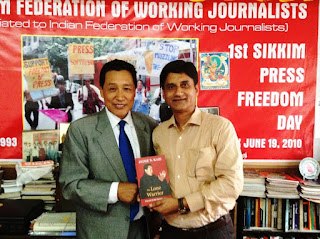CALLS ON FORUM PATRON-IN-CHIEF
JUSTICE MN VENKATACHALIAH, THANKS HIM FOR VERDICT SAFEGUARDING BL AND SANGHA
SEAT
GANGTOK, 29 Apr: Author and journalist, Jigme N
Kazi has been made the president of Sikkim unit of the All India Patriotic
Forum (AIPF). The main objective of the Forum is to “bring patriotism back to
the forefront of consciousness in all citizens” with special focus on the youth
of the country.
A press release informs that former Chief Justice of the Supreme Court of India, Justice MN Venkatachaliah is the Patron-in-Chief of the Forum. Other prominent members of the Forum include Gen. (Retd.) SF Rodrigues, Lt. Gen (Retd.) and former Governor of Assam and JK SK Sinha, former Judge of Supreme Court N Santosh Hegde and former Chief Secretary of Sikkim KS Rao.
Kazi has also been made a member of the 11-member National Advisory Council of the Forum. Sonam Dorjee, a senior teacher of Tashi Namgyal Academy (TNA), Gangtok, has also been appointed Secretary and Treasurer of the Forum’s Sikkim unit.
The release mentions that Mr Kazi also called on Justice Venkatachaliah this week where he thanked the former CJI for the Supreme Court’s historic verdict in the Assembly seat case. In 1993, Justice MN Venkatachaliah had given a historic verdict upholding reservation of the Bhutia-Lepchas and Sangha seats.
Mr. Kazi also presented his books – Inside Sikim: Against the Tide and The Lone Warrior: Exiled In My Homeland – to the former CJI. (Ref: Sikkim NOW April 2014)
A press release informs that former Chief Justice of the Supreme Court of India, Justice MN Venkatachaliah is the Patron-in-Chief of the Forum. Other prominent members of the Forum include Gen. (Retd.) SF Rodrigues, Lt. Gen (Retd.) and former Governor of Assam and JK SK Sinha, former Judge of Supreme Court N Santosh Hegde and former Chief Secretary of Sikkim KS Rao.
Kazi has also been made a member of the 11-member National Advisory Council of the Forum. Sonam Dorjee, a senior teacher of Tashi Namgyal Academy (TNA), Gangtok, has also been appointed Secretary and Treasurer of the Forum’s Sikkim unit.
The release mentions that Mr Kazi also called on Justice Venkatachaliah this week where he thanked the former CJI for the Supreme Court’s historic verdict in the Assembly seat case. In 1993, Justice MN Venkatachaliah had given a historic verdict upholding reservation of the Bhutia-Lepchas and Sangha seats.
Mr. Kazi also presented his books – Inside Sikim: Against the Tide and The Lone Warrior: Exiled In My Homeland – to the former CJI. (Ref: Sikkim NOW April 2014)

















.jpg)
.jpg)
